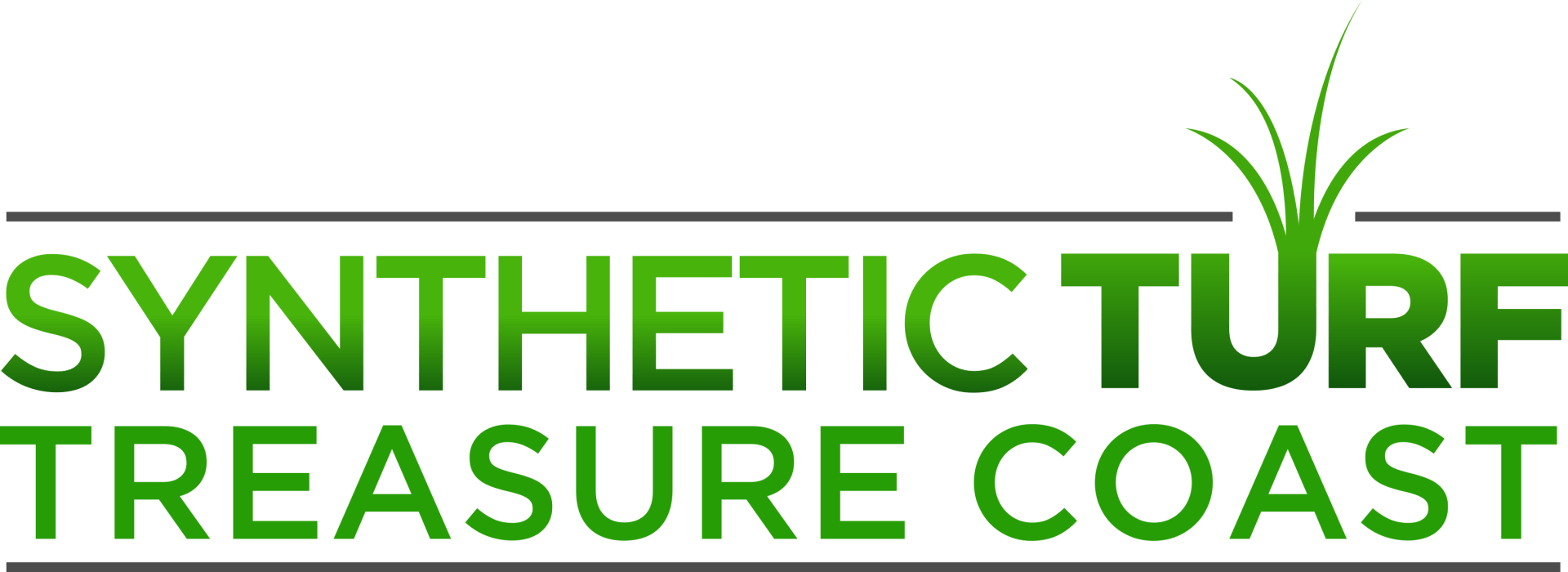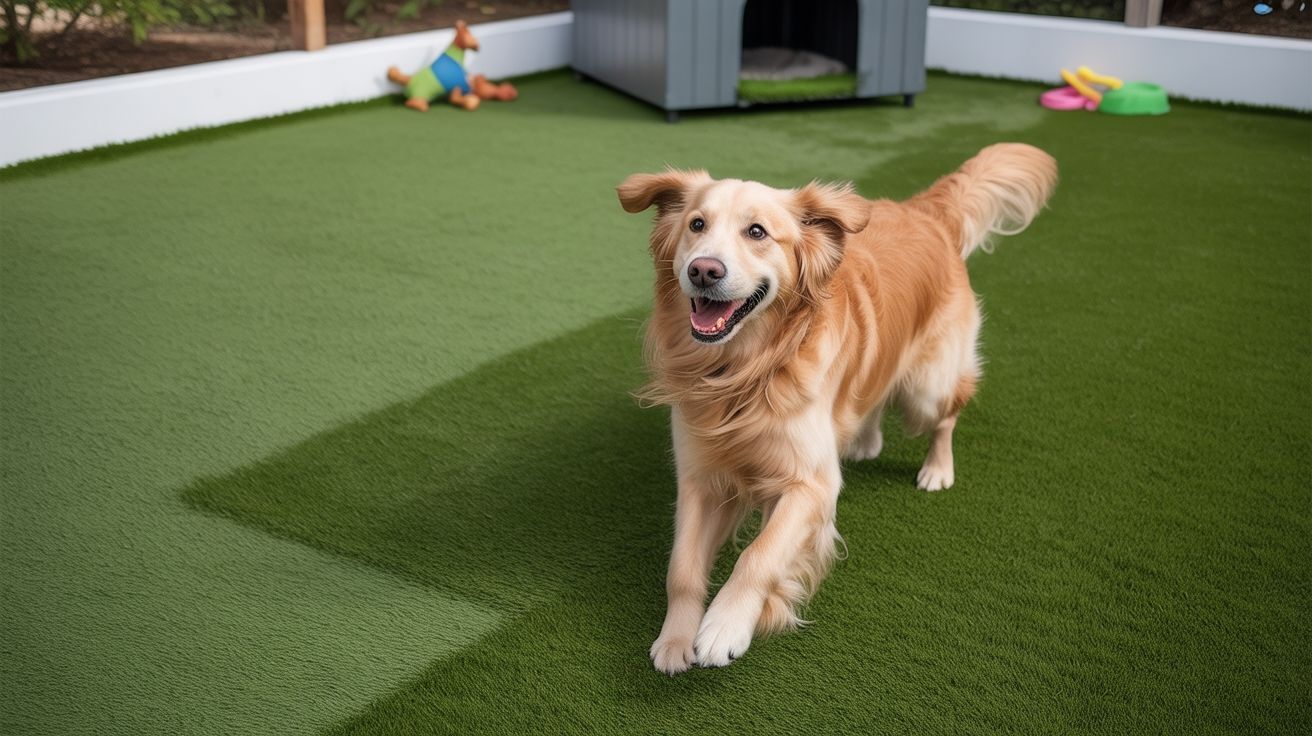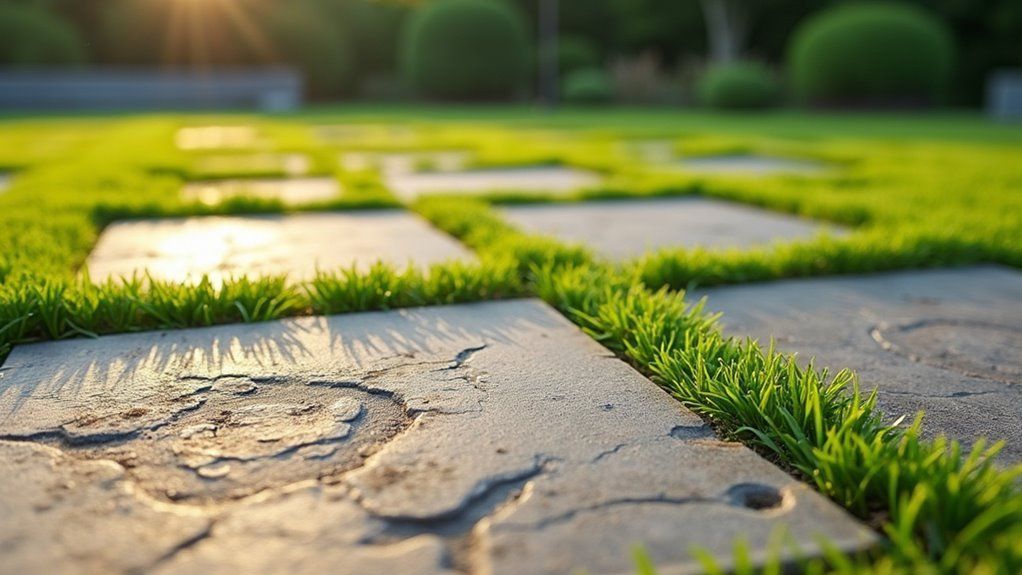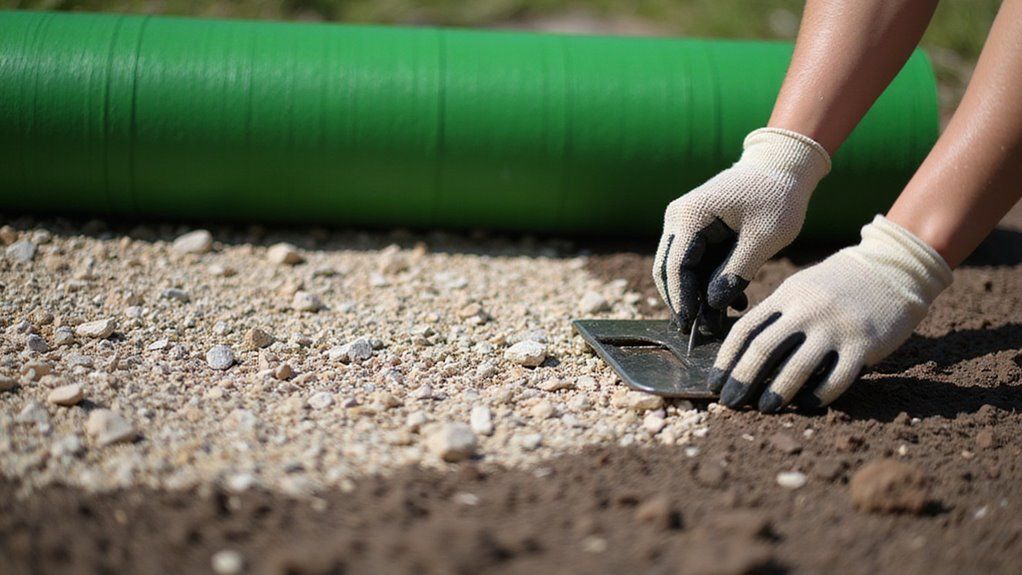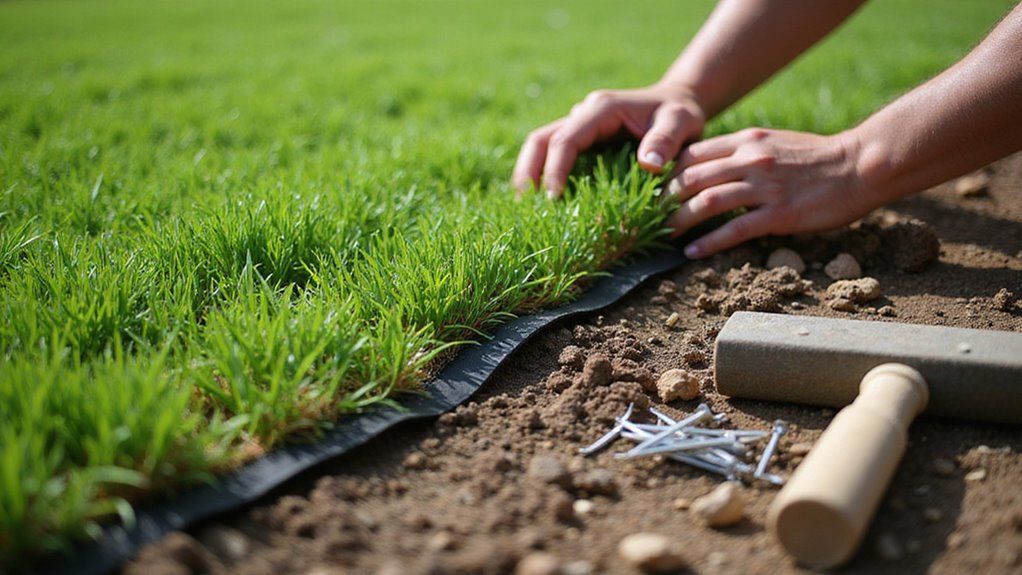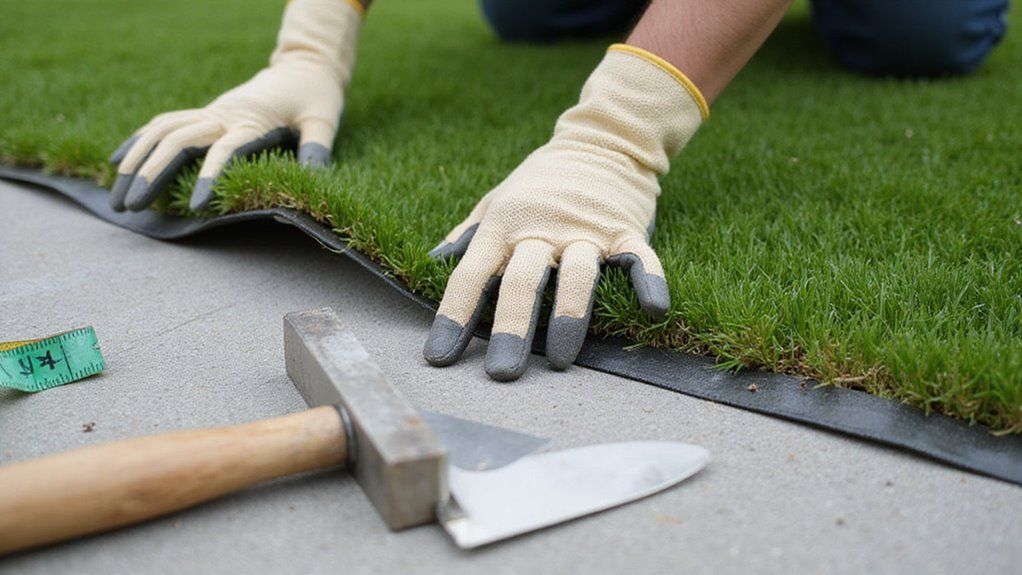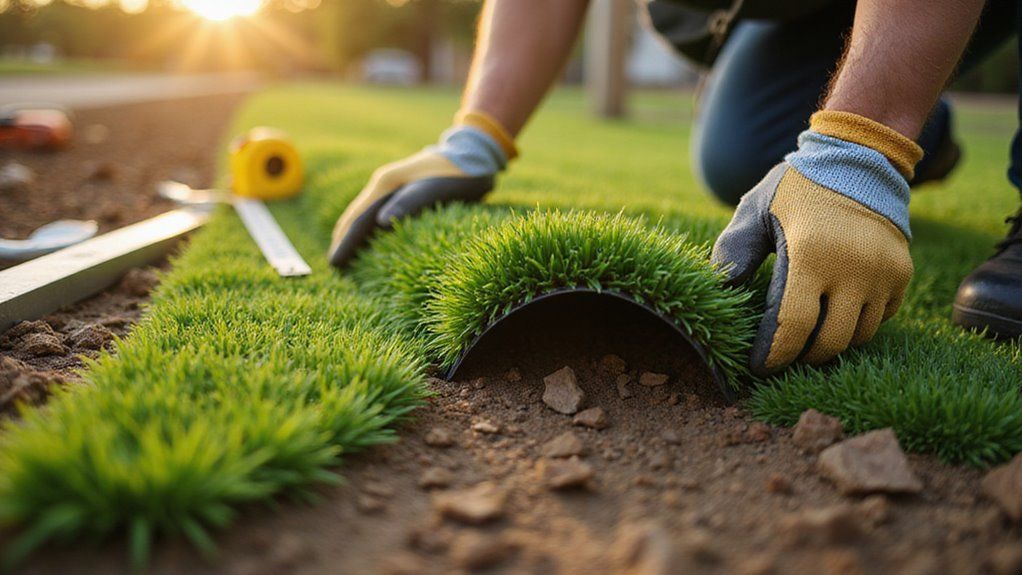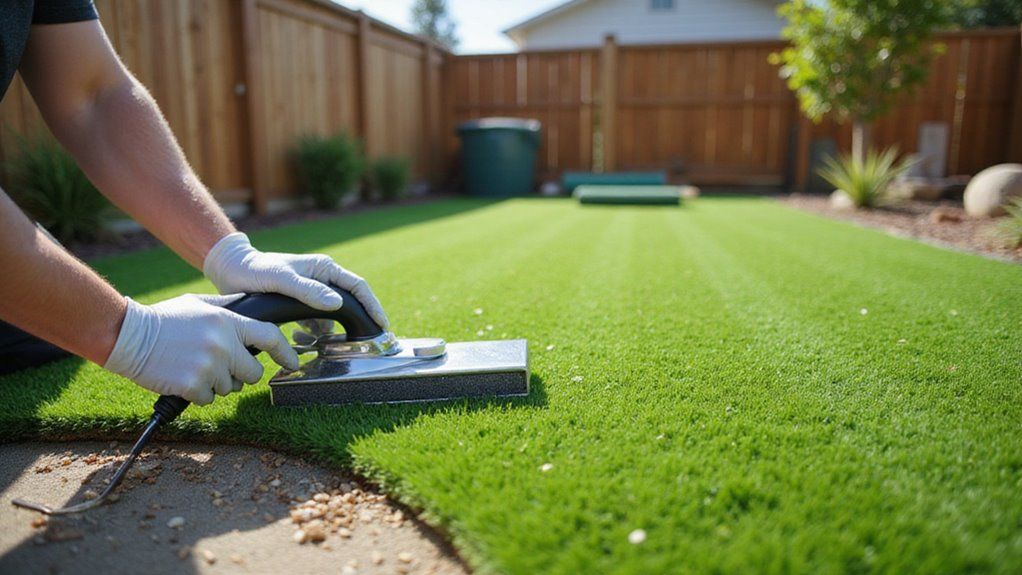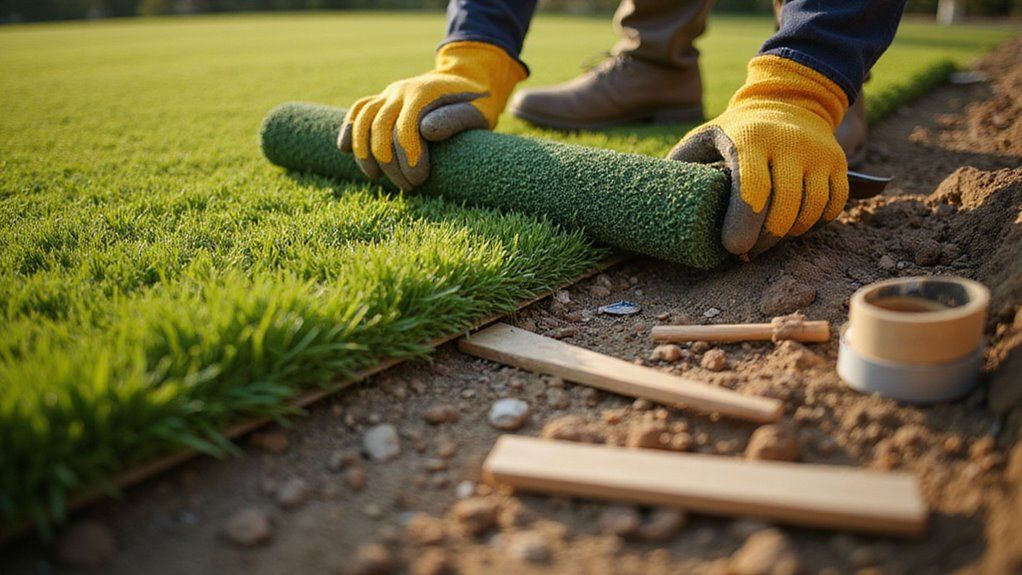How to Clean Artificial Grass?
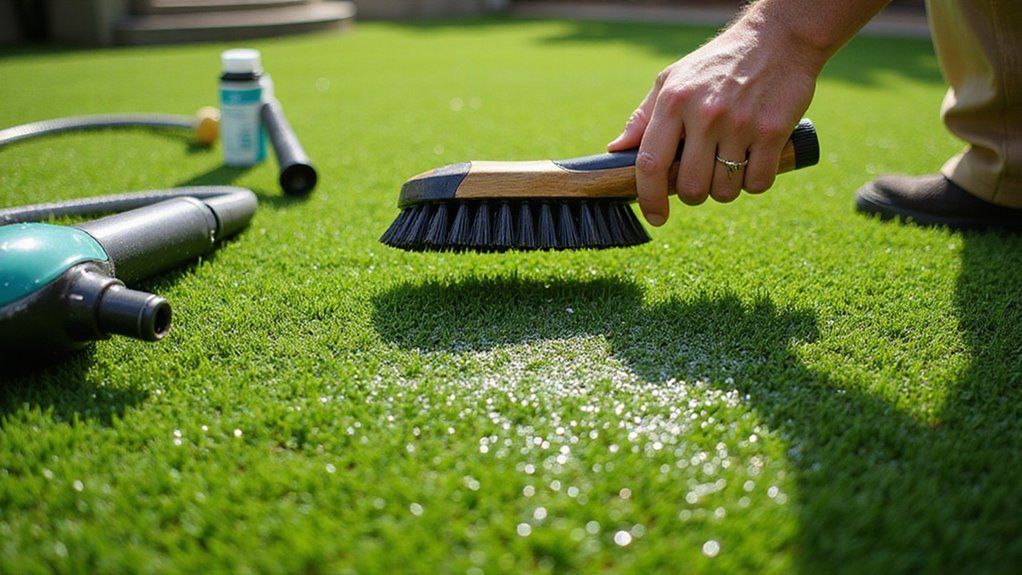
Maintaining artificial grass isn't as simple as "set it and forget it." Many homeowners discover their synthetic lawn looking dull, matted, or harboring unpleasant odors after several months. Without proper care, debris builds up between the fibers, drainage becomes blocked, and those antimicrobial properties gradually fade away.
The consequences of neglect can be costly and frustrating. Pet waste can create lingering smells that become increasingly difficult to eliminate. Weeds might find ways to grow through the backing material. The pristine appearance you paid for slowly transforms into an eyesore that fails to enhance your property's appeal.
Fortunately, a consistent cleaning routine can prevent these problems and extend your turf's lifespan. To clean artificial grass properly, you need to rinse regularly, brush the fibers, remove debris, and use appropriate cleaning agents for specific issues. Following the right maintenance schedule keeps your investment looking fresh while preserving its functional benefits.
This guide provides step-by-step instructions for effective artificial grass cleaning to protect your investment and maintain its appearance.
Key Takeaways
- Brush artificial grass weekly with a synthetic-bristled broom against the grain to prevent matting and keep fibers upright.
- Remove organic debris using a leaf blower on low power or a plastic rake with soft bristles.
- Clean pet waste immediately and treat areas with enzyme cleaners or a vinegar-water solution to eliminate odors.
- Spot clean stains with mild soap and warm water, using ice cubes to freeze substances like gum before removal.
- Rinse the turf regularly with a garden hose to remove dust and maintain cleanliness while keeping drainage channels clear.
Essential Tools for Artificial Grass Maintenance
Proper artificial grass care requires specific tools for the best results. A leaf blower helps remove loose debris quickly from your synthetic lawn. Stiff-bristle brooms lift matted fibers and restore the upright appearance.
Plastic rakes are safer for dethatching because they won't damage the turf backing. A garden hose with spray nozzle works well for regular rinsing. Enzyme cleaners can remove pet odors and stubborn stains.
Power brushes with synthetic bristles provide deeper cleaning for high-traffic areas. Turf vacuums extract small particles that hide between grass blades. Professional sanitizing sprays kill bacteria that might grow under the surface.
Tools last longer when stored properly after each use. Hang your rakes and brooms to prevent bristle damage. If you keep equipment organized in one place, you'll maintain a more consistent cleaning schedule.
Regular maintenance ensures your artificial turf longevity while supporting environmental sustainability through reduced water consumption and elimination of pesticides.
Weekly Brushing Techniques to Prevent Matting
Regular brushing prevents matting in artificial grass. You should brush your turf once a week using a synthetic-bristled broom or specialized turf brush. This schedule may increase during periods of heavy use.
Work against the grain of fibers to lift them back to their upright position. This counters the natural flattening from foot traffic and weather. Cross-brushing works best—brush in one direction, then at a right angle.
High-traffic areas need extra attention. These spots tend to mat down faster than other parts of your lawn. If people walk on certain areas more, brush those sections more thoroughly.
Store your brushes properly between uses. Hang them with bristles up or lay them flat in a clean, dry place. Proper storage will make your brushes last longer and work better.
Using a hard broom with synthetic bristles only helps maintain your artificial turf's appearance while preventing damage to the grass fibers.
Removing Organic Debris and Fallen Leaves
Artificial turf needs regular cleaning to remove leaves, twigs, and plant matter. This maintenance keeps your lawn looking good and helps water drain properly. Use a leaf blower on low power to avoid disturbing the infill material.
A plastic rake with soft bristles works well for stubborn debris. Metal tools can damage the synthetic grass fibers. You might want to install mesh screens during fall in areas where leaves collect most.
Quick cleanup prevents moss and weeds from growing in decomposing plant matter. Check drainage holes and channels after you remove debris.
These pathways must stay clear for proper water flow, especially after storms or heavy leaf fall. For high-traffic areas, consider using a stiff bristle brush to sweep turf fibers upright and maintain their natural, lush appearance.
Tackling Pet Waste and Eliminating Odors
Pet owners must clean waste quickly and remove odors from artificial grass. Solid waste should be picked up right away. Then rinse the spot with water and use special turf cleaners for tough spots.
Odor neutralizers help prevent ammonia buildup from pet urine. Enzyme cleaners work well for monthly deep cleaning. A mixture of equal parts vinegar and water can clean small areas cheaply.
Commercial deodorizers keep your turf smelling fresh between cleanings. Always rinse thoroughly after using any treatment. This helps wash away dissolved waste through the drainage holes.
Never use bleach or harsh chemicals on your artificial grass. These products can damage the backing material. They also kill helpful bacteria that naturally fight odors.
The anti-microbial coating on quality artificial turf helps prevent bacteria growth and reduces persistent odors between cleanings.
Effective Methods for Spot Cleaning Stains
Quick action is needed for stains on artificial grass. Blot liquid spills with towels to remove excess moisture. Avoid rubbing as it pushes stains deeper.
Food, paint, and oil stains need mild soap mixed with warm water. Apply this mixture with a soft brush using circular motions. Rinse well with clean water to avoid soap buildup.
Ice cubes can freeze tough substances like tree sap or gum. Once frozen, you can scrape off the hardened material easily. Rust marks require special turf cleaners that contain oxalic acid.
If stains persist, you might need to try stronger cleaning solutions. Always test cleaners on a small area first. Professional cleaning services can help with stubborn stains that won't come out.
For best results, make sure to use eco-friendly cleaning detergent specifically designed for your type of artificial grass to avoid damage to the fibers.
Seasonal Deep Cleaning Procedures
Your artificial turf needs regular seasonal care beyond daily spot cleaning. This helps maintain its beauty and extends how long it lasts. You should adjust your cleaning schedule based on your local weather and how much you use your lawn.
Follow this simple cleaning plan throughout the year. In spring, clear away winter debris and use a safe cleaner to kill bacteria. Consider applying a deodorizer if pets use the area frequently.
Summer requires brushing against the grain to lift flattened fibers. This restores the turf's natural look after heavy use during warm months. Water can help remove dust and small particles during hot weather.
Fall maintenance focuses on removing leaves before they decay. Use a leaf blower on low setting or a plastic rake for best results. Quick action prevents mold growth that can damage your turf.
In winter, never use metal tools on your artificial grass. Plastic snow shovels are safe for removing snow without cutting fibers. If ice forms, let it melt naturally rather than using harsh chemicals.
For deep cleaning needs, consider adding crushed stone layer beneath your turf during installation to improve drainage and prevent water accumulation that could damage the fibers.
Natural Solutions for Moss and Weed Control
Controlling moss and weeds on your artificial turf requires effective natural alternatives to harsh chemicals. You'll find vinegar solutions particularly effective for moss elimination, while strategic baking soda applications can prevent regrowth without damaging synthetic fibers.
Essential oil mixtures, particularly those containing clove or peppermint oil, offer residual protection against persistent vegetation when applied at regular intervals. Using these natural methods helps maintain the non-toxic materials in your artificial grass while eliminating the need for harmful pesticides and fertilizers that can create chemical runoff.
Vinegar Moss Treatments
Vinegar kills moss on artificial turf without harmful chemicals. You can mix equal parts white vinegar and water in a spray bottle. Spray directly on moss patches and avoid getting it on other plants.
Try adding baking soda for tough moss problems. One tablespoon per cup of vinegar solution works well. Essential oils like tea tree or eucalyptus can also help fight fungal growth.
Sunny, dry days are best for vinegar treatments. The moss will turn brown and can be brushed away later. Weekly treatments may be needed until all moss is gone.
Always rinse the turf after the moss dies. This prevents vinegar from damaging your artificial grass fibers. Your turf will stay clean and moss-free with proper care.
Baking Soda Applications
Baking soda kills moss and weeds on artificial grass safely. It creates an environment where moss cannot grow. Your synthetic grass fibers will remain undamaged during treatment.
Mix one cup of baking soda with two gallons of warm water. Use a garden sprayer to apply this mixture evenly on problem areas. Let it sit for about an hour before rinsing with clean water.
Baking soda works because it changes pH levels and gently scrubs surfaces. You can make a thicker paste for stubborn moss by using less water. Gentle scrubbing with a soft brush helps remove tough growth without harming the turf backing.
If you want to prevent moss growth, apply a diluted solution every three months. Focus on shady areas where moss typically grows. This simple maintenance keeps your artificial grass looking fresh year-round.
Essential Oil Solutions
Essential oils offer natural alternatives for synthetic turf care. You should mix 15-20 drops with one cup of water. This mix works well against moss and weeds without harming turf fibers.
Different oils serve different purposes on your synthetic turf. Tea tree oil fights moss while keeping your turf looking good. Clove oil breaks down unwanted plants, drying them out within two days.
Peppermint oil prevents new weeds from growing with its natural deterrent properties. Citrus oils work best when applied in the morning. They can reach weed roots more effectively during this time.
Use a fine-mist sprayer for application. Target only problem areas instead of spraying the entire surface. This approach helps protect beneficial microorganisms in your turf.
Managing High-Traffic Areas on Your Synthetic Lawn
High-traffic areas on synthetic lawns require strategic maintenance to prevent matting and premature wear. You'll need to rotate furniture placement regularly, brush the flattened fibers against their natural grain with a stiff-bristled broom, and immediately address spills or stains in these zones before they become embedded. Consider using a specialized turf vacuum instead of traditional vacuums for occasional cleaning of heavily used areas to avoid damaging synthetic fibers and disrupting the infill.
These proactive measures extend your artificial turf's lifespan and maintain its aesthetic appeal in areas subjected to constant foot traffic or weight pressure.
Rotate Furniture Regularly
You need to move outdoor furniture on fake grass often. This stops lasting damage from weight pressing down on one spot. Moving chairs and tables every 30 days helps keep your lawn looking good.
Always lift furniture when moving it. Dragging can harm grass fibers and shift the infill material. You might want to mark where items usually sit to help with rotation.
Add furniture rotation to your monthly lawn care plan. This makes it easier to remember this important task. You can check how well pressed areas recover after you move the furniture.
Regular moving prevents grass fibers from staying flat too long. When weight is shared across different spots, your artificial lawn will last longer. This simple habit protects your investment.
Brush Against Grain
Brushing artificial grass against its natural direction helps lift flattened fibers. Use a stiff broom or special turf brush for this task. Work in the opposite direction of how the grass normally lies.
Apply medium pressure with short, firm strokes when brushing. Start from the edges of flat areas and move toward the middle. You'll see the grass stand up again quickly.
High-traffic areas need brushing every two weeks. A power brush with nylon bristles works well for very flat sections. If you use metal bristles, they might damage your artificial lawn.
Spot Clean Immediately
Clean spills on artificial turf as soon as they happen. Quick action stops stains from setting into the fibers. This keeps your lawn looking good and lasting longer.
High-traffic areas collect more dirt and wear over time. Spills in these spots need extra attention. If you wait too long, the stain might become permanent.
Use absorbent towels to blot liquids gently. Never rub the area, as this pushes the spill deeper. Mix water and dish soap for most organic spills.
Work from the outside of the stain toward the center. Rinse the area completely with clean water after cleaning. Soap residue can damage turf if left behind.
Some stains like tree sap need special artificial turf cleaners. You can remove most substances if you act within minutes. Should a difficult stain appear, consult your turf manufacturer for specific advice.
Winter Care Tips for Artificial Turf
Artificial turf requires special care during winter months. Frost, snow, and drainage issues need proper attention. Regular maintenance protects your investment and extends its lifespan.
Frost can damage artificial grass fibers if you walk on it. Wait for frost to melt naturally before using your lawn. Never break ice formations manually as this tears the material.
Snow removal should be done with plastic shovels that have rounded edges. Work in the same direction as the grass blades when clearing snow. Leave a thin layer of snow on the bottom to protect the turf.
A leaf blower on low setting helps dry your turf after snow removal. Good drying prevents mold growth underneath the surface. You should check the area frequently during thawing periods.
Drainage systems must stay clear during winter. Remove leaves and debris from perimeter drains monthly. If water pools anywhere, your drainage system might need immediate attention.
Check infill levels after storms or heavy snowfall. Proper infill distribution maintains the turf's structure and appearance. Your artificial grass will last longer if drainage works correctly.
Using a stiff brush against the grain helps restore fibers that become flattened under heavy snow and ice.
Addressing Stubborn Spills and Sticky Substances
Removing sticky substances from artificial grass requires specific techniques tailored to each contaminant type. For gum removal, freeze the area with ice cubes before carefully scraping off the hardened residue, while pet waste demands immediate pickup followed by a targeted enzyme cleaner application.
Oil stains necessitate quick action with a sorbent material such as cat litter or cornstarch, followed by a specialized turf-safe degreasing solution to prevent permanent discoloration.
After addressing any stubborn spills, a thorough rinse with a mixture of water and vinegar will help eliminate remaining oils and restore the turf's appearance.
Gum Removal Techniques
Fast action can save your artificial grass from gum damage. Proper removal methods will dissolve or freeze the gum without harming the turf. Different approaches work for various situations.
Apply ice in a plastic bag directly on the gum for 15-20 minutes. The gum will harden completely. You can then scrape it off with a plastic putty knife.
Citrus-based products can break down the sticky gum compounds. These commercial solutions are designed specifically for synthetic surfaces. They work by dissolving the polymer bonds in the gum.
White vinegar helps with stubborn gum spots. Pour it on the affected area and let it sit for 10 minutes. Then brush the gum away gently.
If you have many gum spots, use a special artificial turf cleaner. Apply it to the sticky areas working from outside toward the center. This method prevents spreading the gum further.
Always test cleaning products on a small hidden area first. This precaution ensures the solution won't damage your grass. If discoloration occurs, try a different removal method.
Pet Waste Solutions
Artificial turf owners need specific cleaning methods for pet waste. Remove solid waste quickly with a scooper or bag. Rinse the area with water to stop residue from soaking into the backing.
Create a bathroom spot on your fake grass for your pet. Train them to use this area every time. Flush urine spots with water right away to weaken the concentration.
Use enzymatic cleaners made for synthetic grass to remove pet smells. These cleaners break down organic matter instead of just hiding odors.
If smells persist, mix equal parts water and white vinegar as a solution. Spray this mixture on smelly areas and rinse well afterward. Don't use ammonia products because they can make urine smells worse and harm your turf.
Oil Stain Treatment
Oil stains need quick action to prevent lasting damage to artificial grass. First, blot the spill with paper towels to soak up excess oil. Never rub the stain as this pushes oil deeper into fibers.
Try these effective absorbent materials for lightening stains. Dry cat litter or oil absorbent granules can be pressed into the stain for 2-3 hours. A mild dish soap solution works well when gently massaged into the affected area.
For petroleum-based stains, apply mineral spirits on a clean cloth. If the stain is old, make a paste with baking soda and let it sit for 30 minutes. You should vacuum all residue after the treatment dries.
Always rinse the treated area thoroughly with clean water. Brush the grass fibers upright once everything is dry. This final step helps restore the natural look of your artificial grass.
Professional Cleaning Services vs. DIY Maintenance
Professional cleaners offer deep cleaning and infill redistribution once or twice a year for synthetic turf. They use special equipment that most homeowners can't easily get. This thorough service helps your artificial grass last longer.
DIY maintenance costs less and works well for regular upkeep. You should brush your turf weekly with a non-metal rake and hose it down monthly. Treat stains quickly when they happen.
Homeowners need some basic tools for self-maintenance. A leaf blower, stiff brush, and proper cleaning solutions are essential.
These items make regular care much easier.
Your choice depends on your budget and available time. Yards with heavy use or pets may need both approaches. You might handle regular cleaning yourself while hiring professionals once a year.
Extending the Lifespan of Your Synthetic Grass
A well-maintained artificial grass installation can last 15-20 years. Proper care prevents damage and keeps your synthetic turf looking fresh. Regular maintenance saves you money by avoiding early replacement costs.
Watch for seam separations that worsen with regular foot traffic. Check for matted fibers that might block proper water drainage. Sun damage in exposed areas can fade and weaken the grass fibers over time.
Brush the grass regularly to keep the blades standing upright. Deep cleaning every three months removes hidden dirt and prevents bacteria growth. If you notice small depressions forming, fill them promptly to prevent water collection.
Keep lawn mower clippings from natural grass away from your artificial surface. Never use petroleum-based cleaners as they damage the backing material. Heavy machinery should not be operated on synthetic grass under any circumstances.
Water Conservation Benefits During Cleaning
You'll conserve substantial water when cleaning your artificial grass compared to maintaining a natural lawn. Implement efficient techniques such as spot-cleaning with minimal water and using specialized cleaning solutions that require less rinsing.
Consider collecting and filtering rinse water for ensuing cleaning sessions, maximizing resource efficiency while maintaining your synthetic turf's appearance.
Reduced Water Usage
Artificial grass needs much less water than real lawns. Regular lawns use about 55 gallons per square foot each year. You only need a little water to clean fake grass now and then.
You can save water by collecting rain in barrels for cleaning. High-pressure nozzles clean well but use 70% less water than regular hoses. If you clean before rain is expected, nature will help rinse your turf.
Good cleaning products matter too. Choose cleaners that break down naturally so you won't need lots of rinsing. This approach prevents waste and protects the environment.
Your artificial grass stays water-efficient when you clean it properly. Smart cleaning methods keep your environmental benefits going for years. The small amount of water used for maintenance is far less than what real grass needs.
Efficient Cleaning Methods
Save water when cleaning artificial turf by focusing on dirty spots instead of spraying everything. A low-flow nozzle can cut water use by up to 70%. These tools direct water exactly where needed.
First remove loose debris with a leaf blower or special rake. Then clean stains with small amounts of water. You might collect rainwater in barrels for cleaning your turf.
Pet waste areas need enzyme cleaners that don't require much rinsing. A timer-controlled spray system prevents wasting water during regular cleaning. Artificial turf only needs deep cleaning four times a year.
Reusing Rinse Water
You can save water by collecting and reusing rinse water from artificial grass cleaning. A simple slope design helps water flow into barrels or tanks for later use. This method can cut your water use by half during maintenance.
Your environmental impact will decrease as less water enters sewage systems. Utility bills will be lower each time you clean your turf. Pre-used water helps maintain good pH levels, which makes your artificial grass last longer.
This approach is especially helpful during water restrictions in your community. If you want best results, add a basic filter to remove soap and dirt before storage. A small pump will make it easy to use the saved water for your next cleaning session.
Child and Pet-Safe Cleaning Solutions
Children and pets often play on artificial grass. Safe cleaning options protect them from harmful chemicals. Choose plant-based products instead of ammonia or bleach.
A mixture of water and white vinegar works well for daily cleaning. This solution removes dirt without leaving toxic residue. You can apply it with a spray bottle for easy application.
Enzymatic cleaners work best for pet messes on artificial turf. They break down organic matter and eliminate odors naturally. If your pet uses the area frequently, these cleaners will maintain freshness.
Hydrogen peroxide (3% solution) offers another safe cleaning option. It breaks down into water and oxygen after use. Always test any new cleaner on a small hidden area first.
Conclusion
Proper cleaning maintains your artificial grass's appearance and extends its lifespan. Regular brushing prevents matting and keeps the blades upright. If spills occur, prompt cleaning with mild soap and water will prevent staining or odors.
Weather conditions may require specific maintenance approaches throughout the year. Leaves and debris should be removed with a leaf blower or plastic rake. During hot weather, occasional rinsing can cool the surface and remove dust buildup.
With minimal effort, your synthetic lawn will remain beautiful for many years. The investment pays off through reduced water bills and eliminated mowing needs. Install your artificial grass with Synthetic Turf Treasure Coast for professional results that last.
About the author
Kathy Leavell
Kathy Leavell is the founder and owner of Synthetic Turf Treasure Coast, a leading provider of synthetic grass solutions for residential and commercial properties in Florida. With over a decade of experience in the industry, Kathy has become a recognized expert in synthetic turf installation, maintenance, and repair. Under her leadership, Synthetic Turf Treasure Coast has earned a reputation for exceptional customer service and high-quality workmanship.
Prior to starting her own business, Kathy worked in sales and marketing roles at several major synthetic turf manufacturers.
